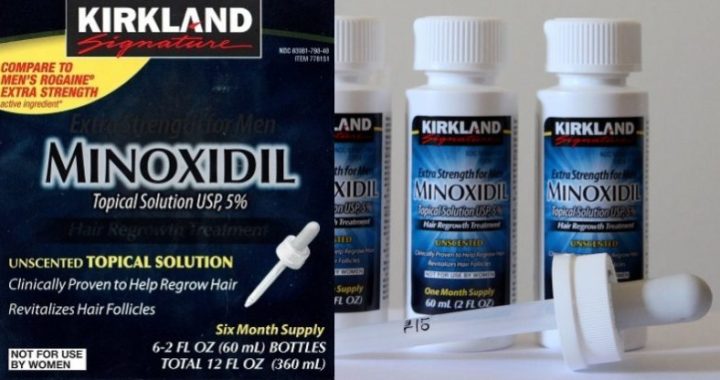Believe it or not, women account for nearly half of all hair loss sufferers.
And the condition usually takes a more devastating toll on women than it does on men. Men are expected to go bald, after all.
Yet most of the web’s minoxidil guides are written for guys. In response, I carefully researched and wrote this in-depth minoxidil review, specifically with women in mind.
In this post, I’m going to talk about the 12 things you should know before you begin a minoxidil treatment regimen.
Before I get started, let me provide you with some background information about minoxidil.
Who It’s For
Minoxidil, the active ingredient in Rogaine, and many other products, is usually the first-line treatment option for female pattern hair loss.
It’s also sometimes used to treat other types of hair loss, including age-related thinning, alopecia areata, and others.
What is Female Pattern Hair Loss?
Female pattern loss is similar to male pattern baldness in many ways, but usually not as severe. Women tend to thin throughout their scalps, whereas men lose hair in more pronounced patterns. Think of the classic “horseshoe” pattern, for example. Unlike men, women rarely go completely bald on top, though women can lose all or most of their hair in extreme cases.
While the stats vary, according to the Canadian Dermatology Association, about 40% of women experience some degree of hair loss by the age of 50.
Signs of Pattern Hair Loss
- Widening part – This is one of the telltale signs of female pattern hair loss. If you’re noticing your part line has seen better days, FPHL is probably the reason why.
- Difficulty styling hair – Maybe your old, go-to styles aren’t working anymore or your ponytail just doesn’t feel as full as it used to.
Excessive hair fall in obvious places – Noticing more hairs in the shower, on your pillow, etc. is sort of the classic sign of genetic hair loss.
Again, Minoxidil is the #1 option for cases of genetic hair loss.
Does Minoxidil Treat Other Types of Hair Loss?
Female hair loss can be challenging to diagnose and treat. Women lose hair for myriad reasons, as I point out in my article describing the 15 most common causes of female hair loss.
Many women notice hair thinning after menopause. General, age-related hair loss is also common. Minoxidil can treat these types of hair loss in women, but you should talk to your doctor first to rule out other potential issues.
Minoxidil is often not recommended for patients with Lupus and other autoimmune disorders known to cause hair loss. Such cases of hair loss are unrelated to androgenic alopecia, the condition minoxidil is more frequently used to treat.
For alopecia areata, an auto-immune disorder that causes hair to fall out in patches, minoxidil is rarely the first-line option. But some patients do use it as a supplementary treatment, with varying degrees of success.
Now that you have some background information about minoxidil, let’s dive right into the 12 things you should know before you try it.
1. Works About 60% of the Time
According to a widely cited 2014 study, 5%, once-daily minoxidil foam works somewhat to fairly well in 60% of women.
2. Not a Quick Fix
Two months is typically the minimum amount of time it takes to see results.
That’s the best-case scenario.
Many users don’t report gains until after six months of consistent use, occasionally longer.
So give it a chance to work and plan for a 6 to 12 month trial.
3. Your New Hairs Could Look a Little…Different.
It’s a relatively common complaint, particularly in the early stages of treatment.
Some minoxidil users, men and women alike, notice that the hairs they grow with the product are of a different color or texture.
They could also be thinner, particularly in the hairline area or other areas where you’re losing ground. This side effect decreases and becomes less conspicuous over time for many users.
If desired, hair dyes can effectively disguise the problem.
4. Foam or Liquid, the Choice is Yours
The foam is slightly less irritating overall. But many people tolerate the liquid without any issues too.
As I say in my post comparing minoxidil foam vs. minoxidil liquid, it comes down to personal preference.
Some users with longer hair have trouble applying the foam evenly.
“It’s too greasy” is a recurring complaint with the liquid. Both products work similarly.
It might not be a bad idea to buy a bottle of both to see which you prefer.
5. 2% Twice Per Day or 5% Once Per Day – Again, the Choice is Yours
The 5% once-daily formula was recently approved by the FDA in 2014.
Most women prefer this option as it’s more convenient. It also may lead to less skin irritation overall.
But either formula can effectively address hair loss in the majority of users.
6. Women are More Sensitive to its Effects than Men
Per daily dosage recommendations, men are supposed to use twice as much minoxidil every day.
7. Hirtruism (Body Hair Growth) Possible
In one study, unwanted body hair growth was reported by 8.9% of female users.
Usually it’s not particularly bothersome and can be addressed with a pair of tweezers. If it becomes a legit problem, the body hair growth will stop once you discontinue treatment.
8. Some Men Use it a Beard Growth Stimulant
Makes sense, right?
While no studies have tested minoxidil as a beard-growth product, it’s used frequently for that purpose. Interestingly, some guys have anecdotally reported permanent beard gains after a treatment round (6-12 months) with minoxidil.
8. It Has a Rather Strange History
Used initially an oral blood-pressure medication, researchers found that hair growth was reported in a high percentage of users.
Looking to cash in on this discovery, the good folks at Pfizer liquidized the medication and took it to the FDA for trials. Rogaine was born in 1988. Ever since, it’s been helping men and women alike retain their locks into their retirement years.
9. Also Prescribed Orally for Hair Loss
While oral minoxidil is still mainly used to treat high blood pressure, it’s also prescribed for hair loss. Prescribed being the operative word. Minoxidil is available over-the-counter in many countries as a topical agent, but the oral medication is only available via a prescription.
The risk of side effects is higher with the oral medication because it enters the bloodstream directly, whereas with topical minoxidil the reaction is mainly localized on the scalp. Prescription minoxidil is also generally well-tolerated.
10. Side Effects are Usually Mild
Minoxidil has an excellent safety profile.
Side effects are mostly limited to skin irritation and other dermatological issues such as redness or peeling.
In most cases the side effects decrease with time.
11. If it Absorbs into Your Bloodstream, More Serious Side Effects are Possible
If the medication goes systemic (into the bloodstream) then other, more serious side effects are possible.
If you notice any cardiovascular disturbances, like palpitations or an elevated heartbeat, be sure to speak with a doctor immediately.
12. Alternative/Supplementary Treatments are Available
With mild hair loss, minoxidil alone may be a sufficient treatment.
In moderate to severe hair loss, stacking therapies will increase your odds of achieving a successful outcome.
As far as over-the-counter hair loss remedies go, there are a variety of proven products that may help including:
1. Ketoconazole
One small trial showed a ketoconazole shampoo was similarly effective to 2% minoxidil. It hasn’t been studied nearly as extensively as minoxidil, but ketoconazole does appear to have some anti-androgenic properties.
The nice thing about this option is that it’s super convenient. You use shampoo every day — or at least most days, I assume — so why not use one that might help thicken your hair a little bit?
As with any treatment, you’ll want to give the product at least a 6 month trial period.
2. Light Therapy
Light therapy has become a more mainstream hair loss solution over the last five years or so. Studies show it can help both men and women manage the condition.
It works differently than minoxidil, so, assuming it works for you, you’ll be helping reduce thinning in multiple ways if you use both products together.
Not all doctors are convinced this therapy works. And laser devices can be expensive, starting around $500. The medical-grade lasers — which are considerably better products overall — start around $1,000.
3. Nanoxidil (Alternative)
A relatively new but promising option, DS labs developed their proprietary . It works similarly to minoxidil, so you’ll want to use either product or the other unless your doctor advises you otherwise.
Minoxidil can be harsh for some people — and like I said, women are more sensitive to it than men. Nanoxidil has a lighter molecular structure than minoxidil and no major side effects have been reported with it.
Minoxidil for Women – Closing Thoughts
Minoxidil is a proven, effective treatment for female hair loss. It works for about 6 out of 10 women, it’s well-tolerated, and it easily be combined with other therapies.
Prescription medications such as finasteride can also be used in conjunction with minoxidil.
Currently, minoxidil sits at the top of my list of the best 12 treatments for female hair loss in 2020. If you have a personal experience with minoxidil or any questions, feel free to leave a comment below.
Robert Price is a writer, consumer advocate, and hair loss researcher with thousands of hours of experience in the field. His goal is to keep you out of the hair loss rabbit hole, underworld, or whatever you want to call it. He founded Hair Loss Daily, the unbiased hair loss blog, in 2016. You can learn more about Robert in the my story section of this website.

